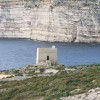
When the Order of St John made Malta and its adjacent islands their home,
they started to fortify Birgu and after the Great Siege of 1565 the built
Valletta and fortified it. These cities were built close to the sea to be
able to defend the island from Turkish fleets attacking from the sea. In
contrast to Malta, Gozo’s fortified city was inland. The Castello in Rabat
was not close to the sea and therefore unable to attack any fleet before it
lands. Gozo was continuously being attacked by Ottoman fleets who used to
plunder this sister island and take its inhabitants as slaves. The 1551
siege on Gozo was the most dramatic when about 6,000 Gozitans were taken
into slavery and the Castello was destroyed. This served as a lesson that
the invader had to be attacked before disembarking.
It was however not before 1605 that the Garzes Tower was built in Mgarr
overlooking the Mgarr Harbour. Grand Master Martino Garzes offered 12,000
scudi for the building of this tower which however was not started before
1605. Grand Master Garzes died in 1601 and so it was his successor Alof de
Wignacourt who ordered its construction in 1605 using the funds of his
predecessor. The Garzes tower was demolished in 1848. In 1616 another tower
was built in Marsalforn on the Qortin tx-Xaghra plateau but this was
dismantled in 1716 as it was in danger of collapse.
The Xlendi Tower was built in 1650 and since the two towers preceding it do
not exist today, this makes this tower the oldest one in Gozo. This is true
if we are not to consider the Comino Tower which was built in 1618. The
Xlendi Tower was first projected by Baliff Baldassare de Demandolx in 1649
and after slightly more than a year it was already completed. It was paid
for by the Universita of Gozo and the Grand Master of the time, Lascaris,
ordered that 2 iron guns be mounted. The Capo Mastro, or commander of the
tower, was paid by the Order and the Universita. The Capo Mastro was a
bombardier and he manned the tower with an assistant or Aggiutante. It is 10
metres square and it has a unique shape as its seaward side has its lower
part protruding out. It was also manned by three guards. In 1681, only 31
years after it was constructed, it was described to be in a bad state and
needed restoration. As with other coastal towers, under British rule the
Xlendi tower was manned by the Royal Malta Fancible Regiment which changed
its name in 1861 to the Royal Malta Fancible Artillery. In 1873 the latter
gave up its coastal guard commitments and so it was abandoned. During the
second World War the tower was used as a Coast Observation Post and was
manned by the Coast Police.
With the advent of the aeroplane and modern warfare, the fortifications
around our islands became useless. The Xlendi tower also lost its military
role and private persons started showing interest to use them. In 1954 the
tower was leased to private persons but was eventually abandoned to its
fate.
The tower is now being restored as a joint venture between Din l-Art Helwa and the Munxar Local Council, expenses on a 50/50 basis. Medserv is sponsoring Din l-Art Helwa’s share of the expenses.








Comments are closed.